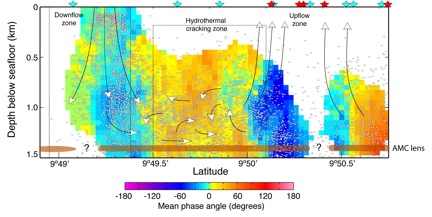Stroup
Systematic Variations in Along-Axis Tidal Triggering of Microearthquakes Observed at 9º50’N East Pacific Rise
D.F. Stroup¹*, M. Tolstoy¹, T.J. Crone¹, A. Malinverno¹, D.R. Bohnenstiehl², & F. Waldhauser¹
Corresponding author: danielle@ldeo.columbia.edu
¹Lamont-Doherty Earth Observatory, Columbia University, Palisades, NY 10964
²North Carolina State University, Raleigh, NC 27695
Abstract:
The permeability structure of subseafloor hydrothermal circulation systems at mid-ocean ridges is a primary control on the geometry of fluid flow, which strongly influences the distribution of heat, chemistry, and biological productivity within new oceanic crust. Despite decades of hydrothermal research, there have been no direct measurements of permeability made at zero-age unsedimented crust. Here we show observations of systematic along-axis variations in the tidal triggering of microearthquake activity at the 9º50'N East Pacific Rise hydrothermal system, and interpret our observations as pore pressure gradients traveling laterally away from the inferred upflow and downflow zones into the hydrothermal cracking zone (Figure 1). Lateral pore pressure gradients may be generated when structural heterogeneities, such as changes in the permeability or in the formation or fluid elastic properties, are present within the hydrothermal cell. We use a one-dimensional poroelastic model for a semi-infinite half-space to describe the tidal phase lag observed within the hydrothermal cracking zone, and find that pore pressure perturbations propagate ~2.0 km along-axis. Based on this ~2.0 km lengthscale, we estimate bulk permeability within the hydrothermal system at ~1.75 x 10-13 to 4.25 x 10-12 m2. This estimate is consistent with on-axis numerical modeling studies (~10-16 to 10-9 m²) and shallow off-axis in situ borehole measurements (~10-15 to 10-12 m²).
Contributions to Integration and Synthesis:
Our observations support the idea of along-axis hydrothermal flow, and help better constrain the physical processes and scale of sustained hydrothermal circulation. In particular, our in situ estimate of permeability will help refine models of heat and fluid flow, and other hydrothermal processes critical to understanding the heat and chemical exchange between the ocean, newly formed oceanic crust, and biological communities.
Figures:
Figure 1: The color of each ~50 m x 50 m grid cell within the along-axis cross-section represents the mean phase angle of the closest 100 earthquakes using a 3D search radius. Regions with low data density (less than 100 earthquakes within a 175 m threshold) have been masked out. Arrows indicate the direction of inferred fluid flow through the hydrothermal cell, following interpretation by Tolstoy et al. [2008]. Statistical analysis was performed on the epicenters located within the downflow zone and hydrothermal cracking zone (black dashed boxes). The locations of high- and low-temperature vents (red and blue stars, respectively) also are shown. From Stroup et al., in press. Stroup_fig1.jpg

